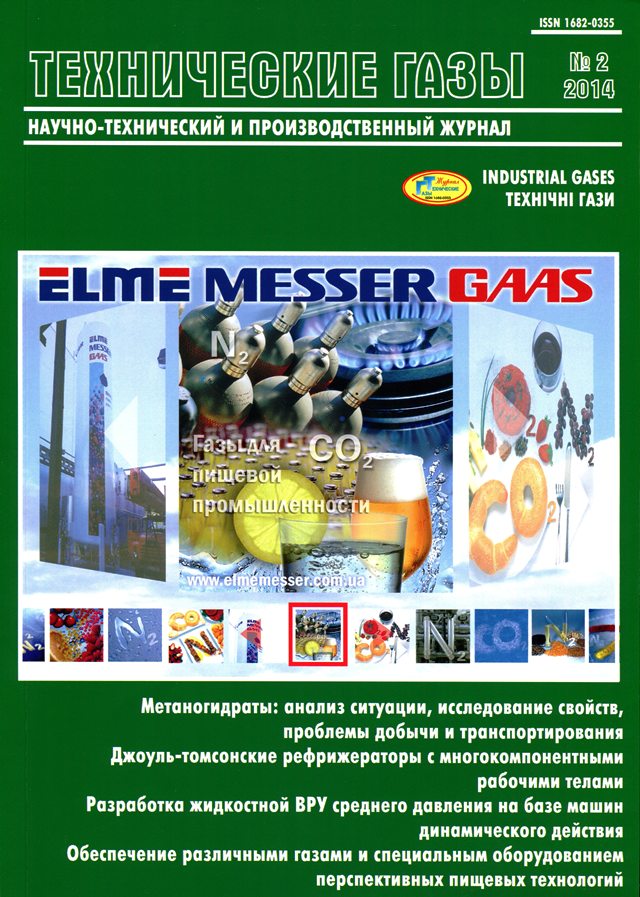JOULE-THOMSON REFRIGERATORS WITH MULTI-COMPONENT WORKING SUBSTANCES
DOI:
https://doi.org/10.18198/j.ind.gases.2014.0718Keywords:
Refrigerator, Multi-component working substance, Thermodynamic cycle, Recuperative heat exchanger, Diagram, Hermetic lubricated compressor, EfficiencyAbstract
Application of mixtures of hydrocarbons as multi-component working substances enables development of simple, reliable and durable Joule-Thomson refrigerators designed for the cooling temperatures within the limits of (–183 ...–73) °С. The temperature, thermal, power and hydraulic parameters of a series of prototypes of the refrigerators developed on the basis of hermetic, small, single stage, lubricated reciprocal compressors mass-producing for various refrigerating sets are reported. The application of the lubricated compressors in the refrigerators down to and including the cooling temperature of –183 °С enables durability of the refrigerators. It has been just this case which offers promise for widespread application of the developed prototypes of the low-temperature equipment incorporating the refrigerators in spite of their slightly lower power efficiency as compared with gas refrigerating machines.
References
Boiarski M.J., Brodianski V.M., Longswort R.C. (1998). Retrospective of mixed-refrigerant technology and modern status of cryocoolers based on one-stage, oil-lubricated compressors// Advances in Cryogenic Engineering. — V. 43. — P. 1701-1708.
Lavrenchenko G.K. (1982). The optimal multi-component working substances assembly for throttle refrigerators// Kholodilnaya tekhnika i tekhnologiya. [Refrigeration Engineering and Technology]. — Iss. 34. — P. 69-77. (Rus.).
Gong M.Q., Luo E.C., Zhou Y., Liang J. T. (2000). Optimum composition calculation for multicomponent cryogenic mixture used in Joule-Thomson refrigtrators// Advances in Cryogenic Engineering. — V. 45. — P. 283-290.
Musaev A.A., Brodjanskij V.M., Bojarskij M.Ju. (1978). Experimental investigation of low-temperature single stage refrigerating machines operating by mixtures of refrigerants// Kholodilnaya Tekhnika. [Refrigeration Engineering]. — № 12. — P. 10-14. (Rus.).
Klimenko A.P. (1964). Separation of natural hydrocarbon gases. — Kiev: Tekhnika. — 377p. (Rus.).
Venkatarathnam G., Srinivasa Murthy S. (1999). Effect of mixture composition on the formation of pinch points in condensers and evaporators for zeotropic refrigerant mixtures// Int. Journal of Refrigeration. — V. 22. — P. 205-215.
Naer V.А. (1999). Refrigerating machine for chambers of heat and cold operating by use of a mixture of refrigerants// Kholodilnaya tekhnika i tekhnologiya. [Refrigeration Engineering and Technology]. — Ess. 62. — P. 133-139. (Rus.).
Hirata T., Fujiwara K., Gyorog T. (1999). Verbesserung von Fahrzeug –Klimaanlagen// Luft und Kaeltetechnik. — V.12. — P. 623-627.
Bondarenko V.L., Naer V.A., Simonenko Ju.M. (2007). Cryogenics in modern medicine// Kholodilnaya tekhnika i tekhnologiya. [Refrigeration Engineering and Technology]. — № 2. — P. 1-7. (Rus.).
Naer V., Rozhentsev A. (2002). Applikation of hydrocarbon mixtures in small refrigerating and cryogenic machines// Int. Journal of Refrigeration. — V. 25. — P. 836-847.
Downloads
Issue
Section
License
LICENSE AGREEMENT
After receiving an article for publication as required revision scientometric databases each author directs the license agreement on the assignment and transfer of the management of copyright. Signatures of the author (s) it is desirable to seal the personnel department of the institution where the author works (authors), or the seal of the Faculty.
Revision refers to the authors one layout for proofreading. Permissible only those fixes that result in compliance with the layout of the original text of the article. Significant changes are not permitted. Layout should be sent to the editorial office within days of receipt.

